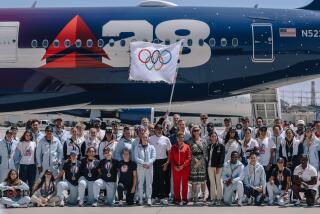Old Clunker Finds Fame on New Circuit : Engineering: University students get a charge out of building electric car for race.
- Share via
LONG BEACH — The sticker on the back of the shiny white 1966 Karmann Ghia says it all:
“Gasoline only . . . NOT!”
This car operates solely on electricity.
“When you are at a stoplight, it doesn’t sound like it’s on,” said Kurt Pickle, a senior mechanical engineering student at Cal State Long Beach. “It makes a high-pitched whining noise. It is very quiet compared to a regular combustion engine.”
Pickle was among 12 mechanical engineering students who converted the car to electricity in six weeks, just in time to enter the first International Electrical Grand Prix. They won--but the competition was not tough. The Karmann Ghia was the only car in the university division.
Since then, the car has been displayed at two engineering conventions as an example of how easy and relatively inexpensive it is to convert gas-guzzling automobiles into rechargeable, silent-running electric cars.
With the help of donations from Chevron, Southern California Edison Co. and the Cal State Long Beach Associated Students, the students were able to repair the car and convert it to electricity for $6,500.
But to the students involved in the project, the car also is evidence of what a group of dedicated future engineers can do with limited funds and a lot of hard work.
“I think it was 1 o’clock in the morning when we finally got it running and drove it around campus,” Pickle said. “Completing it was a big thrill to kind of show people we could do it.”
Powered by 15 special six-volt batteries that weigh 975 pounds, the car can reach 70 m.p.h. and has a range of 81 miles on a single charge. If the batteries are drained, Pickle said, they take about 12 hours to recharge, but with normal driving, charging time is cut to eight or 10 hours.
The American Society of Mechanical Engineers student chapter paid $600 for the dilapidated Karmann Ghia that faculty adviser Bruce Torby said “needed everything.”
Students stripped the car to the body and frame, completely rewired it and removed the gasoline tank, radiator, fuel pump, starter and fuel lines. The students worked nearly every day, sometimes 22 hours a day, in the garage of the now-discontinued Technology Education Department on campus.
As the work progressed, Torby watched several of his students’ grades plummet.
“They were crazy,” Torby said. “They spent hours on it. . . . I think it was a labor of love. They’ve certainly learned a lot.”
It was during the early morning hours of intense work that Pickle said he began to wonder if they would ever finish.
“At times it looked very bleak,” Pickle said, “and we had people who were saying, ‘No way, you can’t do it.’ ”
But they did. The old clunker was transformed into a sporty electric beauty complete with a new paint job. They finished with just hours to spare before the grand prix, a three-day road rally from Santa Monica to Riverside in mid-October.
The race was a contest of vehicles powered by electricity, human energy and the sun. Although the Cal State Long Beach students had no competition in their division, their victory was not as easy as it might seem.
On the first day of the race, the car’s battery charger was not operating properly and the car rolled to a stop about halfway to the goal. The students plugged it in to a power source along the route to try to recharge it, but finally had to have it towed to Santa Monica College where they could work on it, Pickle said. After struggling under the hood much of the night, they resumed the race.
Then the charger caught fire. They finally reached the finish line first (and only) in their division and 26th out of 41 entries in the race.
But the students’ goal was more than winning a race. They wanted the car to be an example of what can be done to improve the environment.
Torby said electrical cars would cut down considerably on noise and air pollution and would help the area comply with state clean-air regulations.
Beginning in 1998, the California Air Resources Board will require 2% of each car manufacturer’s production, or a total of roughly 40,000 vehicles a year, to produce no emissions. By 2003, the percentage will increase to 10%, or a total of about 200,000 vehicles a year.
Since the road race, the Karmann Ghia has become a techno-celebrity of sorts.
“People found out about it and everyone wants to see it. They were amazed we were able to complete it in such a short time,” Pickle said with a laugh. “People were asking us how many years we spent on it.”






